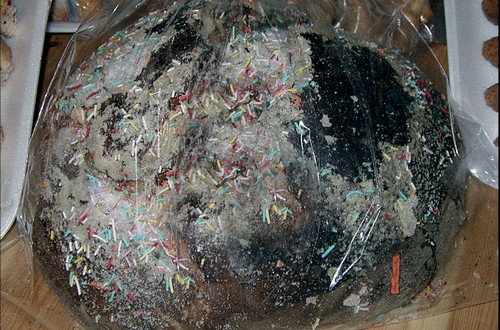Prodotti Tradizionali della Campania
PUCCELLATO DOLCE e PUCCELLATO SALATO

Dalla trasformazione fonetica e gastronomica del “buccellato”, l’antico pane che in epoca tardo romana veniva dato ai militari, la cui etimologia deriva da “buccello”, boccone, è nato il puccellato, una specialità pasquale le cui origini sono talmente antiche da perdersi nella memoria della gente del comune dove è stato inventato, Fragneto l’Abate, in provincia di Benevento. Si tratta di un prodotto da forno la cui ricetta originale è stata tramandata di generazione in generazione ed è sicuramente di epoca pre-medievale, dato che viene menzionato in alcuni documenti del XII come pagamento per i fitti che gli inquilini dovevano ai padroni. Ne esistono 2 versioni, una dolce ed una rustica, che si differenziano per l’utilizzo di alcuni ingredienti, ma che sono identiche nella lavorazione. La base è un impasto di 5 uova con la farina che, nella versione dolce, va mischiato con abbondante zucchero e burro e poi aromatizzato con vaniglia, liquore, cedro e uva passa, mentre in quella salata, prevede l’aggiunta di sugna, pepe grosso ed appena un cucchiaino di zucchero. Man mano che si impasta, vanno aggiunte altre 7 uova ed il lievito e poi si deve lasciare a riposo per oltre 2 ore prima di dare alla massa la forma di una panella, che deve lievitare a lungo prima di essere infornata. Sia nella versione dolce che in quella salata il puccellato è immancabile nel periodo pasquale sulle tavole delle case di Fragneto l’Abate e nei comuni limitrofi, e si può acquistare nei laboratori artigianali della zona.
![]() Puccellato
derives its name from the phonetic and gastronomical transformation of
the word “buccellato”, the ancient bread that was given to
soldiers in the late Roman era, and the etymology of “buccello”,
mouthful. The origins of puccellato, an Easter specialty, are so remote
to be lost even in the memories of the people from Fregneto l’Abate,
near Benevento, who invented it. It’s made in the oven and the
original recipe has been passed down through generations and it surely
dates from before the Middle Ages, since it’s mentioned in documents
from the 12th century as payment for rent. Two versions exist: a sweet
and a savory version, different for some ingredients but made in the
same way. The base is made mixing 5 eggs and flour, in the sweet version
with plenty of sugar, butter and natural aromas like vanilla, liquor,
citron e sultanas. The savory version is mixed with suet, black grain
pepper and a spoon of sugar. During kneading 7 eggs and yeast are added
to the dough and then it’s left to rest for over 2 hours before
working it into the panella shape, which has to rise a lot before being
baked. Either version of the Pucellato is always present at the tables
of Fregneto l’Abate in Easter and can be bought in local workshops
as well.
Puccellato
derives its name from the phonetic and gastronomical transformation of
the word “buccellato”, the ancient bread that was given to
soldiers in the late Roman era, and the etymology of “buccello”,
mouthful. The origins of puccellato, an Easter specialty, are so remote
to be lost even in the memories of the people from Fregneto l’Abate,
near Benevento, who invented it. It’s made in the oven and the
original recipe has been passed down through generations and it surely
dates from before the Middle Ages, since it’s mentioned in documents
from the 12th century as payment for rent. Two versions exist: a sweet
and a savory version, different for some ingredients but made in the
same way. The base is made mixing 5 eggs and flour, in the sweet version
with plenty of sugar, butter and natural aromas like vanilla, liquor,
citron e sultanas. The savory version is mixed with suet, black grain
pepper and a spoon of sugar. During kneading 7 eggs and yeast are added
to the dough and then it’s left to rest for over 2 hours before
working it into the panella shape, which has to rise a lot before being
baked. Either version of the Pucellato is always present at the tables
of Fregneto l’Abate in Easter and can be bought in local workshops
as well.